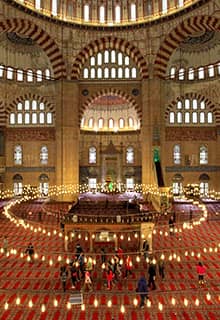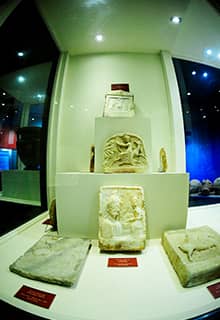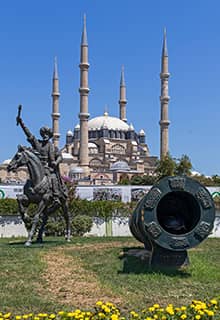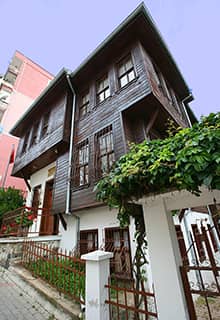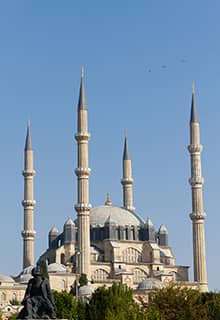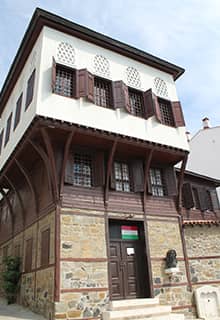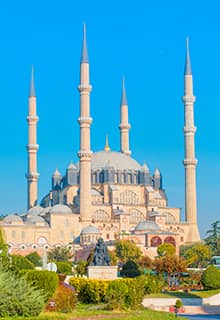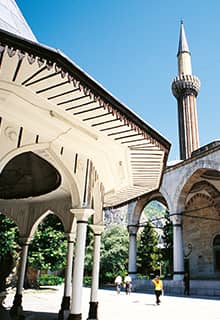

see
Thrace
Kırklareli
In addition to its natural treasures, Kırklareli has valuable cultural monuments and carries the traces of various civilizations. These artifacts are meticulously preserved, and offered to future generations through restoration work. Kırklareli, which is a source of oxygen with its lush forests, is also a well-known destination for nature sports.
Kırklareli, where the first urban life was seen in Thrace, is a city that draws attention with its archaeological findings. The Kırklareli Museum, where the findings obtained from the excavations in the region are exhibited, especially the ancient city of Kanlıgeçit and Aşağı Pınar Tumulus, sheds light on the history of the region with its rich inventory. Also, the 19th century Ottoman civil architecture examples of Kırklareli are worth seeing.
Sokullu Mehmet Paşa Complex
It is spread over a wide area at the entrance of the Lüleburgaz District. The complex built for worship, trade and education between 1569-1570. shows the feature of a complex with its mosque, arched shops, inn, bath and medrese. Built by Great Architect Sinan and his team, the complex expands over an area of approximately 40,000 square meters outside the Byzantine walls, most of which were destroyed. On the west side of the complex, a palace was built by Sokullu Mehmet Pasha for the sultan of the period.
Vize Castle
It surrounds the north and west of the city in the Kale neighbourhood of Vize District. It is estimated that it initially was constructed in the years 72-76 BC. Later, in the Byzantine Period (527-565), it was revived by Justinian. Neatly cut bluish stones were used in the city walls at the northside of the city, which leads to the assumption that this building was rebuilt in the Late Byzantine Period.
St. Nicholas Monastery
The Monastery in the Kıyıköy district is one of the best examples of Byzantine period (6-9th century) rock-cut monasteries. The church is on the ground floor, the holy spring below, and the sections for monks above. There are chambers in the form of levels carved into the rocks. On the north side, a ladder leads down to the holy spring. There is a second entrance to the east of the church.
Babaeski Mosque and Babaeski Bridge
It was built by Cedid Ali Paşa to Mimar Sinan in 1555. It is still used as a mosque. Its single-balcony minaret was destroyed during the Balkan War (1912), and was rebuilt later. The mosque is a small model of the Selimiye Mosque in Edirne
The Babaeski Bridge is another must see place in the Babaeski District. It was built in 1633 during the reign of Ottoman Sultan Murat IV.
Dupnisa Cave
Dupnisa Cave, located in a region with rich natural beauty, where the Istranca Mountains are joined by deep valleys, is a large two-storey underground system with a total length of 2,720 meters consisting of three caves - Kuru Cave, Kız Cave and Sulu Cave. The hydrological features, developmental periods, fauna density, meteorology, and dripstone formations inside the cave are extremely different from each other. It is very interesting that there are three contrasting caves on top of each other. The Kuru Cave at the top is extremely rich in dripstone accumulation. The galleries with stalactites, stalagmites and columns in Kuru Cave are extremely magnificent. Sulu Cave, which is the lowest part of the cave, is 345 meters above sea level and offers a completely different visual richness with its underground streams and lakes, wall and curtain dripstones descending over the lakes. Additionally, about 60,000 bats of 16 species live in the section called Kız Cave.
İğneada and İğneada Floodplain Forest
The İğneada region has a rich biological diversity as its natural balance is preserved. Approximately 670 types of plants have been found in this region. A total of 194 birds such as dwarf cormorant, white-tailed eagle, small kestrel, small green woodpecker in addition to mammals such as deer, roe deer, wild boar, wolf, fox, jackal, wild cat, marten, badger, bats and otter species are seen. The region is home to many reptile and fish species too.
The İğneada Floodplain Forest is one of the rare ecosystems that contain seasonal floodplain forests, marshes, freshwater lakes and coastal dunes. The Istranca Mountains are located in the south and west. Offering different beauties throughout all seasons, the floodplain Forests invite photographers to a visual feast with the variety of colours it offers, especially in autumn. The floodplain forests in this region are a very special type of forest. Additionally, there are five lakes in the area with rich aquatic vegetation. These are the Erikli Lake, which is a lagoon lake disconnected from the sea in summer, the Mert Lake, and the Saka Lake of 5 hectares located in the south of the area, Hamam Lake and the Pedina Lake, which are located in the inner parts.
Tekirdağ
The Pearl of Marmara: A beautiful city with many beautiful sites to offer
Just 150 kilometres from İstanbul, Tekirdağ is a holiday paradise offering cultural heritage, sports activities, salty breeze of the sea and the unique gastronomy at the same time.
You can either go for sports, embrace the natural beauties of Tekirdağ on sea or above the clouds, or you can opt for discovering the local wine and delicacies of the region. In any case, Tekirdağ promises you unforgettable moments.
Tekirdağ, located on Edirne-İstanbul route, became an important summer resort during the Ottoman period. There are many must-see architectural attractions in Tekirdağ city centre, especially the historical Ottoman houses and the Rüstempaşa Complex (Rüstempaşa Külliyesi) which bears Mimar Sinan’s signature.
The museums in Tekirdağ are also important in terms of presenting the historical and cultural riches of the city to its visitors.
Rakoczi Museum
The 3-storey traditional Ottoman house which was home to Hungarian People’s Liberation Hero Ferenc Rakoczi II from 1720 to 1735 and was restored by the Hungarian government to be made into a museum. The museum’s collection comprises, Rakoczi's statue, documents about his life, as well as items used in that period. On the second floor, there are oil paintings of those who participated in the Hungarian independence war with Rakoczi.
Tekirdağ Archaeology and Ethnography Museum
The museum building was initially constructed as the Governor’s Mansion during the early republican period. The four sectioned museum includes stone works hall, archaeological artefacts’ hall, ethnographic artefacts’ hall and the old Tekirdağ room. The museum exhibits cultural heritage dating back to 4500 BCE. The collection includes architectural pieces from the Hellenistic, Roman and Byzantine periods, sarcophagi, stelae, altars, milestones. Inscriptions from the Ottoman period, fountains and fountain mirrors and tombstones are on display in the large garden of the museum.
Rüstempaşa Mosque and its Complex
The Islamic social complex consisted of a mosque, medrese, bedesten (covered bazaar), caravanserai, Turkish bath, imaret and library. Today, the complex’s mosque, hamam, bedesten, medrese and library are still standing. It was built in 1554 under Sadrazam Damat Rüstem Paşa and it bears Mimar Sinan’s signature. The mosque is made of cut limestone and the single balcony minaret is located on its right. The entrance door made out of walnut tree with inlayed ivory. The door wings and window sash are decorated with geometric motifs. The round, 5-column marble fountain in the garden was added under the reign of Abdülmecit.
Namık Kemal House
The museum was founded in memory of Turkish writer, journalist and poet Namık Kemal not far from where he was born in Tekirdağ in 1840. The building is a replica of an old Tekirdağ house. Namık Kemal House exhibits the works of Namık Kemal as well as works written on him.
Sunflower Fields
Enchanting visitors with its natural beauty in all seasons, Tekirdağ welcomes its visitors with a completely different surprise in July. While the sunflower fields stretching as far as the eye can see, colour the city yellow, the fragrance coming from the sunflowers touches your face with the wind. Every year, photographers and nature enthusiasts come to Tekirdağ to enjoy this surreal scenery and immortalize their unique beauty.
Edirne
Edirne was historically known as Adrianople, or ‘‘City of Hadrian’’, named after the Roman Emperor. The city later became the capital of the Ottoman Empire, from 1369 until 1453.
As a gate of Anatolia to the Balkans and Europe, Edirne has a rich variety of historical and cultural attractions. The city that served as the capital of the Ottoman Empire; it is adorned with historical monuments such as inns, mosques, bridges and bazaars. The traces of the city's remarkable past can be seen in these works.
It is difficult to list the “must see” attractions of a city like Edirne, so we will just give you some hints of the places worth seeing and the rest will be up to you.
Selimiye Mosque and its Social Complex
Constructed by the architect Mimar Sinan between 1569 and 1575, the Selimiye Mosque and its complex (Selimiye Cami ve Külliyesi) are listed in the Unesco World Heritage List in 2011. A masterpiece of Turkish art and in the history of world architecture, the Selimiye Mosque is visible from all over the city with its magnificent dome and four slender minarets. Besides its unique architectural characteristics, the mosque evokes admiration with its exquisite details in its carved-stonework and marble, glazed tiles, wood carving and mother-of-pearl inlays.
Edirne Archaeological and Ethnographic Museum
The first museum in Edirne was opened with the name Archaeology Museum (Arkeoloji ve Etnografi Müzesi) in 1925 upon the order of Atatürk. The building was a part of Selimiye Mosque located in the courtyard of Selimiye Mosque and it is the work of Mimar Sinan. And the modern museum consisting of Archaeology and Ethnography sections is opened in 1971. Archaeology section is organised as fossils, coins, stone works, metal works, bone works and terracotta artifacts. Cavalry steles depicting the Thracian cavalry are exhibited in the showcase belonging to Thracian cult objects the grave gifts obtained in the Hacılar Dolmen, Arpalık Dolmen and Taşlıca Bayır Tumulus excavations are exhibited in the showcases called with their names. One of the most interesting parts of the museum is the showcase, which contains female busts made of terra cotta, and it’s interesting in terms of showing the hair styles of women from the Archaic Period until today. And in the ethnography section; silver objects, Şarköy kilims belonging to the 19th century, various embroidered clothes and jewellery, examples of traditional handicraft “Edirnekari” can be seen.
Arasta Bazaar
It is also named as “Kavaflar Bazaar” as it is written by Evliya Çelebi. It is the right address for those who want to shop in an atmosphere where time stands still.
Rüstempaşa Caravanserai
It is built in 1561 by Mimar Sinan and is one of the most magnificent caravanserais of classical Ottoman architecture. There are 21 shops on the façade of the building consisting of two-storey rooms arranged around a rectangular open courtyard. On the second floor of the Büyük Han section, where the large courtyard is located, a typical Turkish bath with floor heating was built and covered with tiles suitable for the period.
Bridges of Edirne
It is not surprising that bridges come to mind when talking about Edirne. Surrounded by the rivers of Arda, Tunca, Meriç and Ergene, the bridges of the city are also the witnesses of great historical heritage. Gazimihal (Hamidiye), Uzunköprü, Saraçhane, II. Bayezit, Fatih (Bönce), Yıldırım, Saray, Yalnızgöz (Tekgöz), Tunca and Meriç (Mecidiye) bridges must be seen during a visit to Edirne.
Turkish and Islamic Arts Museum
In the rooms around the courtyard of the museum located in the Dar-ül Tedris Madrasa of the Selimiye Complex, there are items belonging to the monasteries, wrestlers, weapons, wooden artefacts, Ottoman tiles and ceramics.

